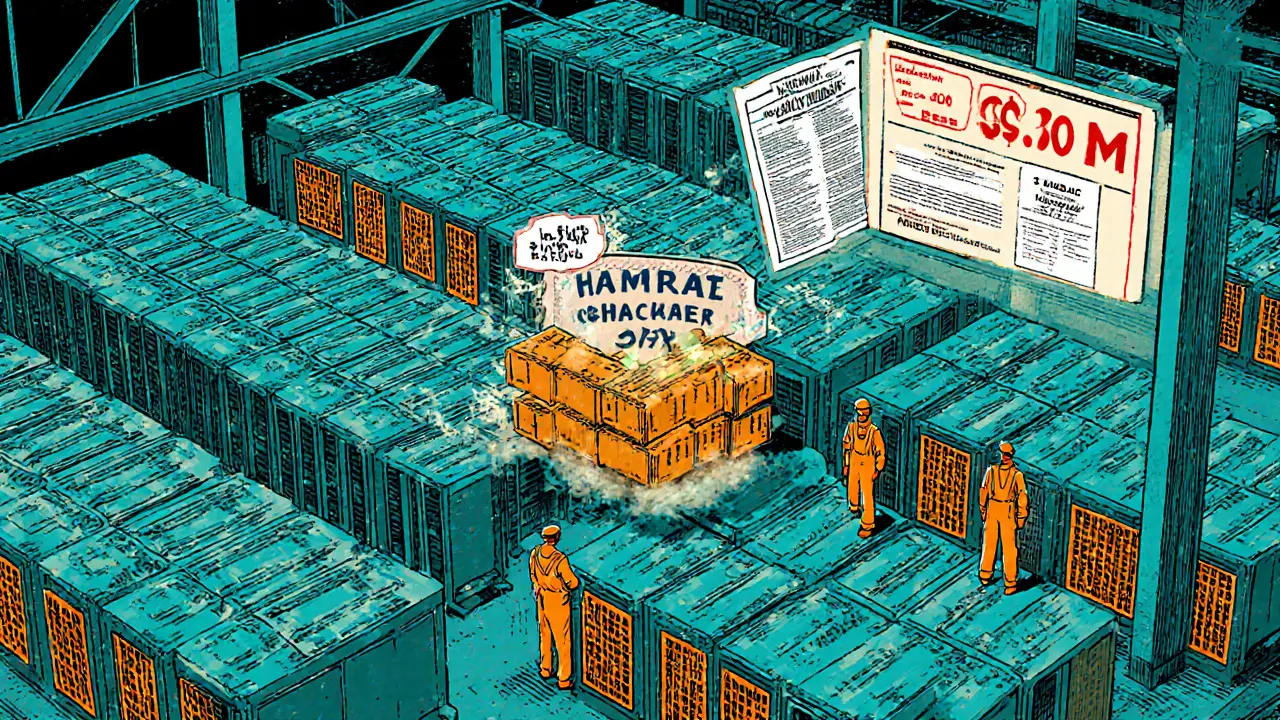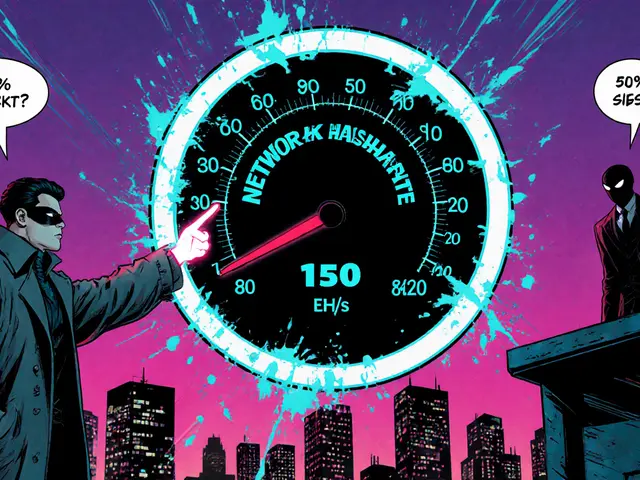Bitcoin 51% Attack Cost Calculator
Includes $6.00M daily electricity costs and ~$22M daily mining revenue forgone.
How This Calculator Works
This tool estimates the cost of a 51% attack on Bitcoin based on:
- Network hashrate (currently ~150 EH/s)
- ASIC miner performance (~110 TH/s per Antminer S19 Pro)
- Cost per ASIC miner ($4,000 average)
- Daily electricity cost per miner ($60)
The estimate assumes the attacker needs to match the full network hashrate (~150 EH/s) to ensure dominance.
When we talk about Bitcoin is the world’s largest proof‑of‑work cryptocurrency, the phrase “51% attack” instantly brings a mix of fear and curiosity. Could a rogue actor really seize control of the network, rewrite history, and double‑spend billions? The answer lies in the numbers: the cost to pull off such an assault is staggering, ranging from several billions to tens of billions of dollars. Below we break down why the price tag is so high, how the math works, and what it means for anyone watching the market.
TL;DR
- Current Bitcoin hashrate ≈ 150EH/s; controlling >50% needs roughly 75EH/s, but most estimates assume a full 150EH/s for safety.
- Buying enough ASICs (e.g., Antminer S19 Pro) would cost between $5.5B and $20B depending on hardware price, electricity, and market pressure.
- Renting or hijacking mining pools is theoretically cheaper but faces huge legal, coordination, and trust hurdles.
- Honest mining yields about 918BTC per day - millions of dollars - making an attack economically unattractive.
- State‑level actors with unlimited resources are the only realistic threat, but even they would face massive diplomatic fallout.
What a 51% Attack Actually Looks Like
In a proof‑of‑work system, the chain with the most cumulative work is considered the valid ledger. If an attacker controls more than half of the total computational power, they can start mining a private fork that eventually outpaces the honest chain. When the private fork becomes longer, the network accepts it, effectively erasing or reversing blocks that were previously confirmed.
This capability lets the attacker double‑spend: they send coins to a victim, wait for confirmations, then switch to their private branch where the original transaction never existed, and reuse the same coins elsewhere. The damage isn’t just financial; it shatters confidence in the entire ecosystem.
Bitcoin’s Current Hashrate Landscape
The metric that drives the cost calculation is the network’s total hashrate - the combined processing power of all miners. As of October2025, Bitcoin’s hashrate sits around 150exahashes per second (EH/s). One exahash equals one quintillion hashes per second, so the scale is almost unimaginable.
To guarantee dominance, an attacker would need to match or exceed this figure. Some analysts argue that a little under 50% of the total (≈75EH/s) could be enough if the attacker times the assault perfectly, but the consensus in security circles is to assume the full 150EH/s for a safe margin.
Physical Hardware Route: Buying the Machines
The most straightforward way to amass that kind of power is to buy dedicated mining hardware. The current workhorse is the Antminer S19 Pro, delivering 110terahashes per second (TH/s) while consuming 3,250watts.
Simple division shows you’d need about 1.36million of these units to hit 150EH/s (150000000TH/s ÷ 110TH/s). At an average market price of $4,000 per unit - a figure that already reflects the premium for bulk orders - the hardware bill alone tops $5.4billion.
But hardware is just the tip of the iceberg. You also have to factor in:
- Shipping and customs: moving millions of heavy devices across borders adds tens of millions.
- Facility costs: you need massive data‑center‑scale spaces, cooling infrastructure, and security.
- Electricity: each S19 Pro draws 3.25kW, so the entire fleet would consume roughly 4.4gigawatts - enough to power a small city. At a global average electricity price of $0.06/kWh, daily energy costs would be around $6million.
- Maintenance and replacement: ASICs have a useful life of 18‑24months. Keeping them online requires a dedicated engineering team.
All told, the end‑to‑end expense stretches well beyond the $5.5billion headline figure, nudging closer to $10‑$15billion once you account for real‑world logistics.
Renting or Hijacking Hashrate: The Synthetic Approach
Instead of buying machines, an attacker could try to rent hashing power from existing miners or infiltrate large mining pools. Services that offer hash‑rate leasing (often called “hashrate rental” or “cloud mining”) can provide terahashes on demand, but prices fluctuate with market demand.
On a typical day, renting 1EH/s of Bitcoin hashpower costs roughly $30‑$40million. To reach 150EH/s, you’d need $4.5‑$6billion in rental fees for a single day of continuous operation. Since the attack would need to run for several days to overtake the honest chain, the total quickly eclipses the hardware‑purchase route.
Hijacking existing pools is theoretically cheaper - you’d just need to convince pool operators to cooperate or compromise them. In practice, that means navigating legal jurisdictions across the United States, Kazakhstan, China, and other mining hubs, while also risking criminal prosecution, civil suits, and massive reputational damage. The coordination challenge alone makes this vector far less appealing than buying hardware, despite its lower upfront cost.

Economic Incentives: Why Honest Mining Wins
Even if an attacker could marshal the necessary hashpower, they’d be giving up a huge source of legitimate revenue. A fully operational 1.36million‑unit fleet would mine roughly 918BTC per day under current difficulty - that’s over $22million in daily earnings at today’s price of $24,000 per Bitcoin.
Choosing to attack means forfeiting that steady income, plus incurring the massive capital outlay described earlier. Most analysts conclude that a rational, profit‑maximizing miner would find the break‑even point years away, if it exists at all.
Furthermore, any successful attack would tank Bitcoin’s price instantly. The attacker’s own holdings would lose value dramatically, erasing any short‑term gains from double‑spending.
Historical 51% Attacks on Other Chains
Bitcoin has never suffered a full‑scale 51% breach, but several smaller networks have. Bitcoin SV endured three attacks in 2021, while privacy‑focused Firo and Ethereum Classic were also hit.
These incidents typically required less than 5% of the total hashpower because the networks were tiny compared to Bitcoin. They serve as proof that a 51% attack isn’t just theory - it’s a real risk for any cryptocurrency with insufficient mining decentralization.
Market Ripple Effects
Beyond the immediate loss of funds, a successful Bitcoin 51% attack would create a cascade of market reactions:
- Price shock: Bitcoin could lose 30‑50% of its market cap in hours.
- Regulatory clampdown: Governments would likely impose stricter rules on crypto mining and exchanges.
- Institutional pull‑out: Companies that hold Bitcoin on balance sheets would reconsider exposure, potentially triggering broader sell‑offs.
- Trust erosion: The narrative of Bitcoin as “digital gold” hinges on its security; an attack would shatter that story.
The sheer magnitude of these secondary costs adds another layer of deterrence for any potential attacker.
Future Outlook: Will Costs Keep Rising?
Two trends suggest that the financial barrier will only get higher:
- Hashrate growth: As more miners join and hardware efficiency improves, the total network power will climb, pushing the 51% threshold upward.
- Energy regulation: Many jurisdictions are tightening rules on energy‑intensive mining, potentially raising electricity prices for large operations.
Some experts predict that within the next decade, the cost of a successful attack could breach $30billion, making Bitcoin one of the most secure (and hardest to sabotage) digital assets on the planet.
Comparison: Physical vs Synthetic Attack Costs
| Aspect | Physical hardware acquisition | Synthetic (hashrate rental / pool hijack) |
|---|---|---|
| Initial capital outlay | $5.5B - $20B (ASICs, facilities, power) | ≈ $4.5B - $6B for one‑day rental (ongoing fees increase total) |
| Operational complexity | High - requires data‑centers, cooling, staff | Medium - must manage contracts, maintain stealth |
| Legal risk | Moderate - ownership is visible but legalities vary | High - involves illicit control of third‑party pools |
| Opportunity cost (lost mining rewards) | ≈ $22M per day of honest mining forgone | Similar loss if rental fees replace mining profit |
| Scalability | Limited by hardware supply and logistics | Limited by market hash‑rate availability and price spikes |
Key Takeaways
Putting the numbers together, a 51% attack on Bitcoin is not just expensive - it’s financially irrational for most actors. The hardware route demands billions in capital and ongoing costs that dwarf any potential profit. The synthetic route may shave off some upfront spend, but it introduces massive legal and coordination hazards, plus rental fees that quickly add up.
Only a well‑funded nation‑state with a geopolitical motive could even contemplate shouldering those costs, and even then the diplomatic fallout would be severe. For everyday investors, miners, and developers, the takeaway is simple: Bitcoin’s massive hashrate and built‑in economic incentives keep the network safe for the foreseeable future.

Frequently Asked Questions
How much hashpower is needed for a 51% attack?
Technically, just over 50% of the total network hashrate would suffice, but analysts usually assume the attacker needs to match the full 150EH/s to guarantee success under worst‑case conditions.
Can I rent Bitcoin hashpower to launch an attack?
Yes, but daily rental fees for 1EH/s run into tens of millions of dollars. Reaching 150EH/s would cost billions, and the attack would need to run for several days, making it even pricier.
What happens to honest miners if an attack succeeds?
Their blocks become orphaned, and the rewards they earned could be invalidated. Moreover, the market crash that follows would slash the value of any Bitcoin they hold.
Why haven’t we seen a Bitcoin 51% attack yet?
The sheer scale of the network’s hashpower creates a cost barrier of billions of dollars, far exceeding the potential profit from double‑spending, and any successful attack would also destroy the attacker’s own holdings.
Do upcoming protocol upgrades affect attack costs?
Upgrades that improve mining efficiency or introduce new consensus layers can raise the baseline hashrate, indirectly increasing the cost of obtaining a majority. So far, no upgrade has reduced the barrier.


Patrick MANCLIÈRE
September 15, 2025 AT 08:08Reading through the numbers really drives home how massive Bitcoin’s hashrate has become, and why a 51% attack feels like something out of a sci‑fi thriller. First, the network sits at roughly 150 EH/s, which translates to an astronomical amount of raw computational power. To even think about matching that, you’d need over a million modern ASIC miners, each churning out 110 TH/s. Those machines don’t come cheap – at about $4,000 apiece the hardware alone tops $5 billion. Then there’s the electricity bill: running a fleet that large would guzzle around 4.4 GW, costing roughly $6 million a day. If you add in shipping, cooling, and facility costs, the total expense can easily climb past $10 billion. The opportunity cost is another massive factor, since honest miners would earn about 918 BTC per day – that’s over $20 million in revenue you’d be throwing away. Renting hashpower isn’t much cheaper; you’d still be looking at billions for just a few days of operation. Even state actors would find the diplomatic fallout outweigh any potential gain. In short, the sheer scale of the required investment makes a Bitcoin 51% attack economically irrational for anyone but a super‑power with a very specific agenda. The network’s size itself acts as a deterrent, keeping the system secure for the foreseeable future. So while the math can be crunched, the reality is that the cost barrier is astronomically high, and that’s a comforting thought for most of us who rely on Bitcoin’s stability.
Carthach Ó Maonaigh
September 20, 2025 AT 08:08Wow, that’s a wallet‑busting price tag.
Marie-Pier Horth
September 25, 2025 AT 08:08The sheer magnitude of these figures underscores the immutable resilience of the Bitcoin protocol, a veritable bastion of cryptographic fortitude in an era of fleeting digital fads.
Gregg Woodhouse
September 30, 2025 AT 08:08meh, looks expensive.
F Yong
October 5, 2025 AT 08:08Sure, if the world’s elites decide to throw billions at a Bitcoin breach, the only thing they’ll really break is their own credibility.
Sara Jane Breault
October 10, 2025 AT 08:08Exactly, the cost alone makes it a non‑starter for anyone thinking about double‑spending.
Noel Lees
October 15, 2025 AT 08:08Those numbers are insane 😂 but kinda reassuring.
Raphael Tomasetti
October 20, 2025 AT 08:08From a technical standpoint, the hashrate ceiling creates a massive economic moat that throttles attack vectors.
Jenny Simpson
October 25, 2025 AT 08:08Honestly, I think the whole 51% panic is overblown – the graph shows it’s practically impossible.
Ron Hunsberger
October 30, 2025 AT 08:08And that impossibility is precisely why the network stays trustworthy for everyday users.
Anurag Sinha
November 4, 2025 AT 08:08Look, I’m not saying it can’t be done, but the logistics of moving millions of ASICs across borders is a nightmare. Even if you could, you’d need a power grid the size of a small country, and the regulatory red tape would slow you down faster than any mining pool could catch up. Plus, think about the market reaction – the moment the rumor spreads, Bitcoin would tank, wiping out the attacker’s own holdings.
Raj Dixit
November 9, 2025 AT 08:08Exactly, the financial incentive just doesn’t add up.
Darrin Budzak
November 14, 2025 AT 08:08It’s nice to see the numbers laid out so clearly.
karyn brown
November 19, 2025 AT 08:08Honestly, if you’re thinking about spending billions on a stunt, you’ve got bigger problems. 🤔